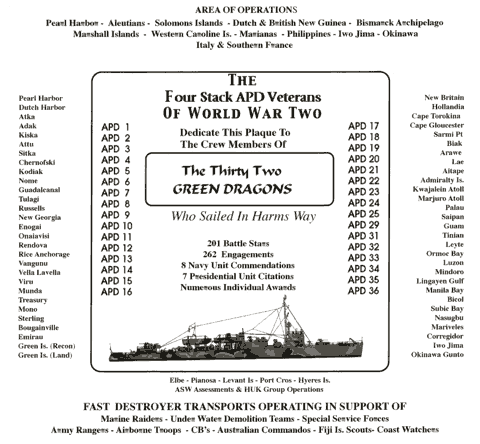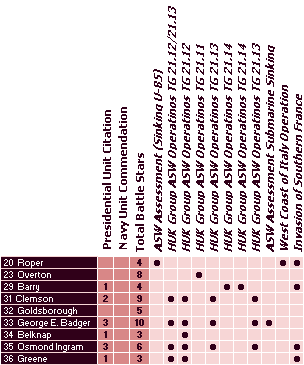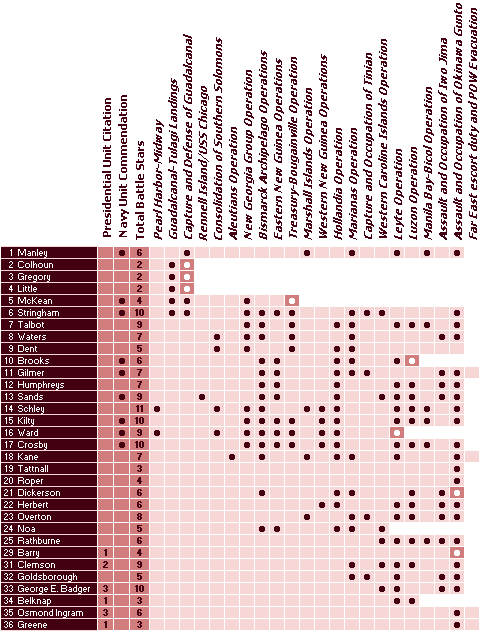

It promptly became apparent that neither side could gain control of the seas, each interrupting the supply lines of the other. As supplies became desperately short, APDs and their Japanese counterparts soon operated in a non-stop disembark-refuel-embark-depart cycle and often found themselves the only nearby help for others in distress. On 23 August, for example, Manley took aboard 99 survivors of destroyer Blue and made Espiritu Santo with only two hours’ fuel on board. Removing all topside weight, her crew painted the ship jungle green and spread camouflage nets. Belching fire and smoke as she and her sisters did in air attacks and shore bombardments, the Marine Raiders soon began calling them “Green Dragons” and formed close bonds with their crews, which last to this day.
Such exposed duty was bound to catch up with them. On the afternoon of 30 August, Colhoun was hit and sunk in a daylight air raid. Boats from Guadalcanal rescued some of her crew but 51 men were killed and 18 wounded.
On the night of 4 September, after Gregory and division flagship Little transferred a Marine Raider Battalion to Savo Island, they observed flashes of gunfire which they supposed came from a Japanese submarine. Unfortunately, so did a Navy plane which dropped a string of five flares almost on top of them. Fatal error! Three Japanese destroyers immediately sighted them off Lunga Point and opened fire, sinking both and then strafing swimmers. Admiral Nimitz reflected, “With little means, the ships performed duties vital to the success of the campaign.”
On 20 June, he sent Waters and Dent with the 4th Marine Raider Battalion to land at Segi Point, to arrive before the Japanese. Thrills in the predawn night came when two large fires—one astern and one on the port beam of the APDs—were lighted by friendly natives, their method of communication with each other. The area thus gained the nickname “Bonfire Bay.” More thrills came as the APDs scraped bottom several times on coral and the only chart available for navigation had the statement “Do not navigate these waters without intimate local knowledge.” The last time the pilot, an Australian, had been there was twenty years before.
On 29 June, TransDiv 22’s Schley, Kilty, Ward and Crosby loaded Army troops and stood out from Guadalcanal for Viru Harbor coordinated with the raiders from Segi Point. Reconnaissance the previous week indicated no defensive gun emplacements there but as the column of APDs neared the harbor entrance at dawn, 30 June, machine gun fire and then heavy shellfire commenced from the high bluffs inside the harbor entrance. The APDs quickly moved out of range and returned fire but landed the troops nearby.


Rendova Island from Blanche Channel (top) and Rendova Strait (above). Rice Anchorage from Kula Gulf (below).

Also on 30 June, the main landings took place at Rendova. III ’Phib’s RAdm. Kelly Turner led attack transports, five APDs of TransDiv 12, flush-deck minesweeper Zane, nine LSTs and eleven LCIs plus escorting destroyers of DesRon 12. In heavy rain, the landings were made without opposition; Zane ran aground only five miles from Munda but fortunately was pulled free before she was discovered.
On 4 July, Stringham, Talbot, Waters, Dent, Schley, Kilty and Crosby plus flush-deck minesweepers Hopkins and Trever, escorted by five destroyers, transported the 1st Marine Raiders to Rice Anchorage in Kula Gulf. RAdm. Ainsworth’s Task Force 18, covering these landings by penetrating deeper in the gulf to bombard Vila and Bairoko Harbor, lost destroyer Strong.
RAdm. Ainsworth was back the next night for the Battle of Kula Gulf, losing cruiser Helena in the “Slot” northeast of Kolombangara. Even after first light, destroyers Nicholas and Radford lingered to rescue almost two thirds of Helena’s men; the next night, Gwin and Woodworth picked up almost a hundred more from New Georgia. But not until the Battle of Kolombangara a week later did word arrive that about 150 more had drifted west across enemy-controlled Vella Gulf to Vella Lavella. Determined Admiral Turner told reporters, “I am sending out all destroyers available to cover the mission, with the APDs to do the actual rescue job. We’ve got to get these men off. That’s all there is to it.”
At noon on 15 July, APDs Waters and Dent stood out for Vella Lavella. Escorted by four destroyers under DesRon 12’s Captain Ryan and covered by four more of Capt. McInerney’s DesRon 21 operating up the Slot, they entered Vella Gulf from the south and closed the island’s uncharted eastern shore. On a night widely remembered as the spookiest of the campaign, destroyer Taylor felt her way inshore with radar and leadline, followed by the APDs. Providentially, their Higgins boats met no opposition but picked up 165 officers and men from two locations—plus nine Chinese, three women, four babies and an American and Japanese pilot.
“It was an impudent thing to do,” said DesRon 12’s Captain Ryan in command, “but it was damned well worth it.”
“Thank you for bringing home so much of our bacon. Well done,” signaled RAdm. Theodore Wilkinson, who had just relieved RAdm. Turner as commander of III ’Phib.
On Sunday 1 August 1943, McKean, Stringham, Talbot, Waters and Kilty departed Guadalcanal with the U.S. Army 27th Combat Team for Onaiavisi escorted by Cdr. Arleigh (later Capt. “31-knot”) Burke with destroyers Maury, Craven, Dunlap and Gridley, the first three to become famous under Cdr. Frederick Moosbrugger a week later at the Battle of Vella Gulf.
The decision to bypass Kolombangara having been taken, the next operation was to land troops and a construction battalion at Barakoma, Vella Lavella to build a fighter strip there. McKean, Stringham, Talbot, Waters, Dent, Kilty, Ward and LSTs with six destroyers under Capt. Ryan arrived and commenced disembarking troops and supplies at 0600, Sunday 15 August. Air attacks began two hours later but caused no damage; covering American fighters claimed 44 attackers shot down.
On 31 October 1943, nine APDs—McKean, Stringham, Talbot, Waters, Dent, Kilty, Ward, Crosby and Dickerson—embarked the 3rd Marine Division at Guadalcanal and stood out for the main Bougainville landings with six destroyers of DesRon 22. Pausing at Rendova to pick up stores and a Pathfinder Hydrographic Party, they rendezvoused with other ships and overnight approached Empress Augusta Bay. Their Higgins boats, launched at 0600 on 1 November under cover of shore bombardment from the destroyers and even the full-size attack transports present, hit the beach north of Cape Torokina without opposition. But this large operation required reinforcements. Returning to Purvis Bay on 4 November, they loaded more Marines at Guadalcanal and, less Dickerson, headed back up the Slot to Bougainville for landings on 6 November. After brief R&R, now also less Kilty, they repeated the trip again, departing 16 November.
At 0300 the following morning, twenty miles from their destination, radar detected several “bogies.” One approached Talbot but turned sharply toward McKean, putting a torpedo into her after magazine and depth charge stowage, which ruptured fuel tanks and set the after part of the ship ablaze. Twenty minutes later, surviving crew and Marines went over the side, shortly before the forward fuel tank and magazine exploded. Sixty-four crew members and 58 Marines were lost.
The Torokina landings were the last offensive operation of the Solomons campaign. APDs continued to operate from Solomon Island bases to Green Island and Emirau, helping isolate Rabaul, but on 25 November, with consolidation of the Solomon Islands complete and on their departure for Australia, Admiral Halsey said good-bye to his APDs:

They also participated in the Marshall Islands operation and supported General MacArthur’s campaign along New Guinea’s north coast.
There followed the invasion of the Marianas and the western Carolines.

As the Okinawa campaign loomed in 1945, Dent drew training duty on the West Coast but the other 23 started arriving in March 1945. There, most escaped damage and some were released during the campaign with the following exceptions:
References: Alden, Friedman, Roscoe, Dictionary of American Naval Fighting Ships, Naval Historical Center, The Famed Green Dragons.